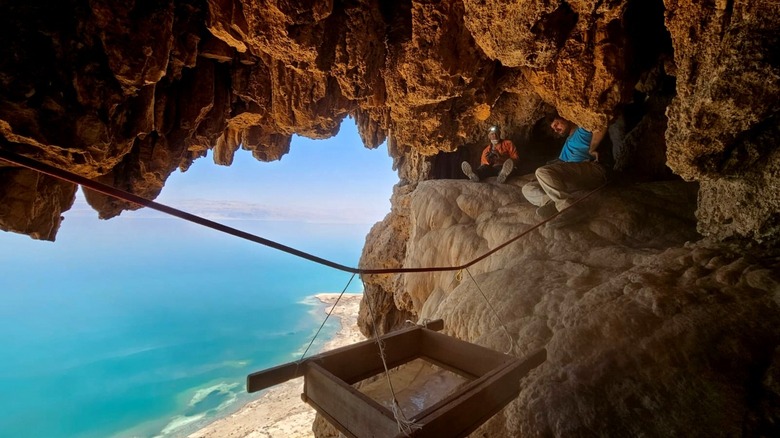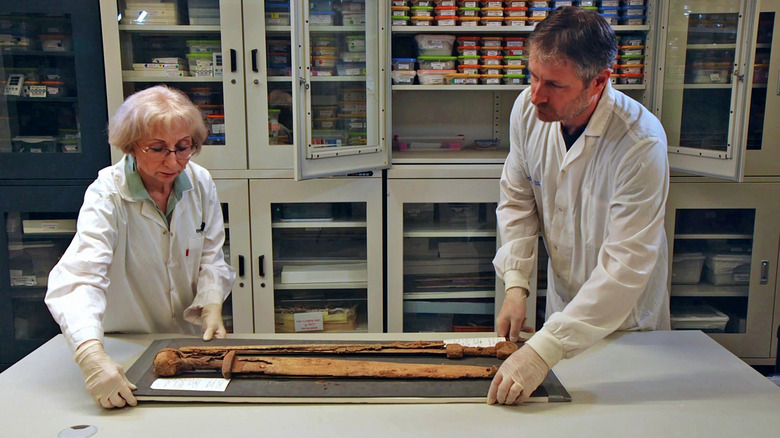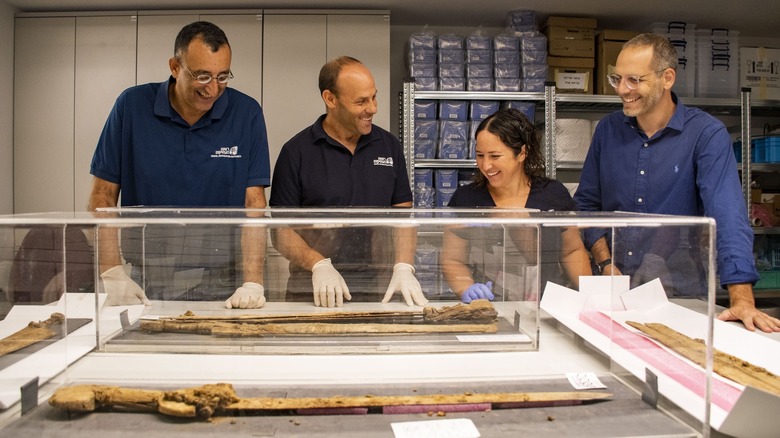The Ancient Weapons Discovered In An Unassuming Cave Close To The Dead Sea
In the Judean Desert, not far from the shimmering salt flats of the Dead Sea, archaeologists made a discovery that sent ripples through the world of ancient history. The site looked unremarkable — a shaded cave tucked into the rocky slopes near the Ein Gedi Nature Reserve. But inside, hidden in a crevice behind loose rock, researchers uncovered four remarkably well-preserved Roman swords alongside fragments of leather and wood. The swords weren't scattered or discarded. They had been tucked away with care — suggesting not a battlefield site, but something more secretive and deliberate.
Found in 2023 by researchers from Ariel University who were on-site to photograph a cave stalactite with an ancient Hebrew inscription written on it discovered some 50 years earlier, the swords could have just as easily gone unnoticed. While inspecting the upper portion of the cave, Ariel University archaeologist Dr. Asaf Gayer noticed a Roman pilum — a long javelin-spear — in a hard-to-reach crevice. Scattered nearby were bits of wood and leather. Clearly, the cave held more than anyone had realized.
When Dr. Gayer later returned to the cave with a team of archaeologists from the Israel Antiquities Authority to investigate the findings in more depth, they discovered four spectacularly intact Roman swords, three of which were still in their wooden scabbards. But how did they get there, and how could they have gone unnoticed for thousands of years?
The Roman swords and their origin
The swords themselves were remarkable, each with either a crafted wooden or metal handle ranging in length from 60–65 centimeters (23–25 inches). Three of the four swords were identified to be Roman spatha swords, used around the first or second century A.D. One of the swords stuck out in particular, being shorter than the rest by several inches and was classified as a ring-pommel sword, another style often associated with Roman infantry.
"The hiding of the swords and the pilum in deep cracks in the isolated cave north of 'En Gedi hints that the weapons were taken as booty from Roman soldiers or from the battlefield, and purposely hidden by the Judean rebels for reuse," Dr. Eitan Klein, one of the directors of the Judean Desert Survey Project, said in a statement. Part of a growing assemblage of ancient weapons found in unassuming places, the swords were part of standard-issue weaponry for Roman soldiers stationed in the Judea region during the Roman period.
As for why they were so carefully hidden, researchers believe that the rebels who managed to come into possession of the weapons were in no rush to be caught by the authorities with the swords on their person. "We are just beginning the research on the cave and the weapon cache discovered in it, aiming to try to find out who owned the swords, and where, when, and by whom they were manufactured," Dr. Klein added. One potential historical event that might tie into the sword's caching is the Bar Kokhba Revolt, a Jewish rebellion against Roman forces in the region from A.D. 132 to 135. Researchers suspect the swords might be tied to the revolt due to the discovery of a bronze Bar Kokhba coin dating from the time of the revolt found during a follow-up excavation of the cave. The dig revealed artifacts dating to the Roman period as well as the Chalcolithic period (some 6,000 years ago).
What the discovery means for Judean Desert history
The discovery of the Roman swords in the Judean Desert cave offers more than just a glimpse into ancient weaponry; it provides a tangible connection to the complex history of the region. The exceptional preservation of these artifacts can be partially attributed to the arid climate of the desert caves, which helped safeguard the organic materials in the swords for millennia. This environment has previously yielded significant finds, such as the Dead Sea Scrolls, offering invaluable insights into not only the cultural and religious practices of ancient societies in the region but also events that shaped its history.
The swords themselves, likely crafted in distant European provinces of the Roman Empire, underscore the extensive reach and logistical capabilities of Roman military operations. The find also enriches our understanding of the Judean Desert's role as a repository of human heritage. A more detailed analysis of the swords and their archaeological context was published by the Israeli research team in a report as part of the book "New Studies in the Archaeology of the Judean Desert: Collected Papers."
It just goes to show how much is still missing from the narrative of human history and how fragile our reconstructions of the past can be. This is further evidenced by the fact that we keep finding ancient ruins in the most unlikely places and the sobering realization that we could be totally wrong about the origins of humans as a species.


